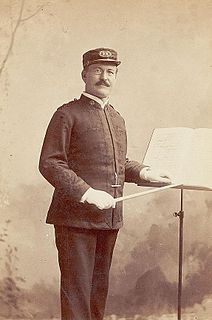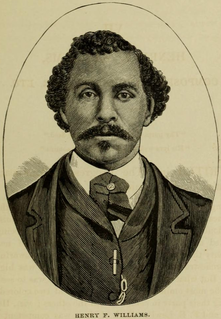
A symphony is an extended musical composition in Western classical music, most often for orchestra. Although the term has had many meanings from its origins in the ancient Greek era, by the late 18th century the word had taken on the meaning common today: a work usually consisting of multiple distinct sections or movements, often four, with the first movement in sonata form. Symphonies are almost always scored for an orchestra consisting of a string section, brass, woodwind, and percussion instruments which altogether number about 30 to 100 musicians. Symphonies are notated in a musical score, which contains all the instrument parts. Orchestral musicians play from parts which contain just the notated music for their own instrument. Some symphonies also contain vocal parts.

William Billings is regarded as the first American choral composer, and leading member of the First New England School.

Alfred Reed was an American neoclassical composer, with more than two hundred published works for concert band, orchestra, chorus, and chamber ensemble to his name. He also traveled extensively as a guest conductor, performing in North America, Latin America, Europe and Asia.

John Milford Rutter is an English composer, conductor, editor, arranger, and record producer, mainly of choral music.
Organized in 1786 as The Stoughton Musical Society, it is America's oldest performing musical organization. For over two centuries it has had many distinguished accomplishments. In 1908, when incorporated under the laws of the Commonwealth of Massachusetts, the name was changed to Old Stoughton Musical Society and it has retained that designation.
Edwin Arthur Jones, was an American composer. He was called "one modest man who knows the power of music" by Edward Everett Hale. These include a masterful cantata and a large oratorio in three parts, modeled after Handel's Messiah.

Patrick Sarsfield Gilmore was an Irish-born American composer and bandmaster who lived and worked in the United States after 1848. While serving in the Union Army during the U.S. Civil War, Gilmore wrote the lyrics to the song "When Johnny Comes Marching Home". This was published under the pseudonym Louis Lambert in September 1863.

The Handel and Haydn Society, familiarly known as H+H, is an American chorus and period instrument orchestra based in Boston, Massachusetts. Founded in 1815, it is in its 207th consecutive season, the most of any performing arts organization in the United States.
The Henry and Leigh Bienen School of Music is the music and performance arts school of Northwestern University. It is located on Northwestern University's campus in Evanston, Illinois.
Patrick Larley is a British composer.

Sir John Frederick Bridge was an English organist, composer, teacher and writer.

The Moravian musical tradition in United States began with the earliest Moravian settlers in the first half of the 18th century.
These Moravians were members of a well-established church – officially called Unitas Fratrum or Unity of Brethren – that by [the mid-18th century] had already seen almost three centuries of rich experience of religious life. They were spiritual descendants of the Czech priest Jan Hus, who for his attempts at reform was martyred in 1415. Forty-two years later in 1457, some of his followers founded a church body consecrated to following Christ in simplicity and dedicated living.
This newly constituted church developed a rich and orderly ecclesiastical life in the 15th and 16th centuries, but in the Thirty Years War of 1618-48 it was virtually wiped out. In the 1720s a few exiles of this religious heritage, along with various other seekers after truth, found refuge on an estate of a Saxon nobleman named Nicholaus Ludwig von Zinzendorf. There in their village of Herrnhut the ancient church experienced a rebirth culminating in a spiritual blessing on August 13, 1727, in which their former diversity of purpose was welded into one.
In a brief five years, by 1732, that first little village of the Renewed Moravian Church began sending missionaries to all corners of the world. After establishing work in England, the Moravians sent colonists to America in 1735. The initial settlement in Georgia proved unsuccessful, partly because of war between Protestant England and Catholic Spain to the south in Florida. More permanent work was established in Pennsylvania in 1741, with the town of Bethlehem as their chief center. Other settlements in Pennsylvania followed. The Moravians purchased 100,000 acres in North Carolina and settled at Bethabara in 1753 with the central town of Salem being founded in 1766.” [Villages of the Lord]
This is a timeline of music in the United States prior to 1819.
This is a timeline of music in the United States from 1820 to 1849.
This timeline of music in the United States covers the period from 1850 to 1879. It encompasses the California Gold Rush, the Civil War and Reconstruction, and touches on topics related to the intersections of music and law, commerce and industry, religion, race, ethnicity, politics, gender, education, historiography and academics. Subjects include folk, popular, theatrical and classical music, as well as Anglo-American, African American, Native American, Irish American, Arab American, Catholic, Swedish American, Shaker and Chinese American music.
This is a timeline of music in the United States from 1880 to 1919.

The World's Peace Jubilee and International Musical Festival of 1872 took place in the Back Bay area of Boston, Massachusetts. Patrick Sarsfield Gilmore directed the festival, which lasted some 18 days. The jubilee honored the ending of the Franco-Prussian War.

Carl Zerrahn was a German-born American flautist and conductor. His widespread activity in the region made him an influential figure in New England and Boston classical music, especially choral music, in the latter half of the 19th century. He was especially successful in the presentation of the great oratorios and the management of large choruses.

Henry F. Williams was a musician and composer in Boston, Massachusetts, in the late 19th century. He was one of two black musicians to play in the orchestra at the 1872 National Peace Jubilee. His arrangements received widespread popularity. Later in his life he was primarily a music teacher. Williams has been called the second best known black composer of his time after Frank Johnson, with whom he worked.
Carl Strommen is an American composer, music pedagogue and conductor.












